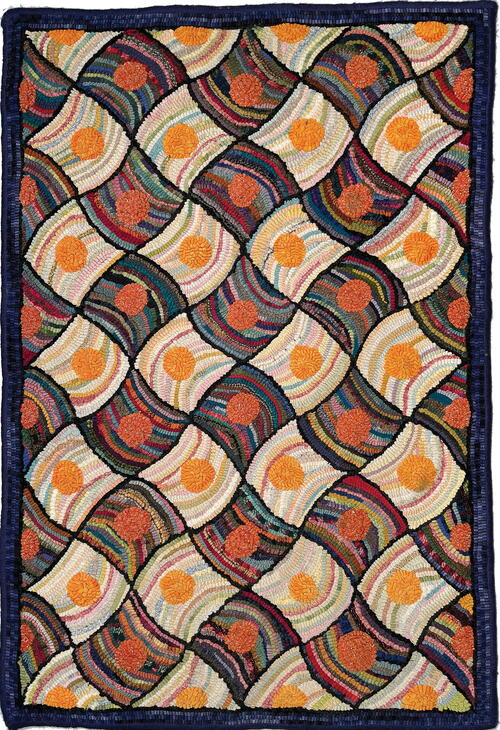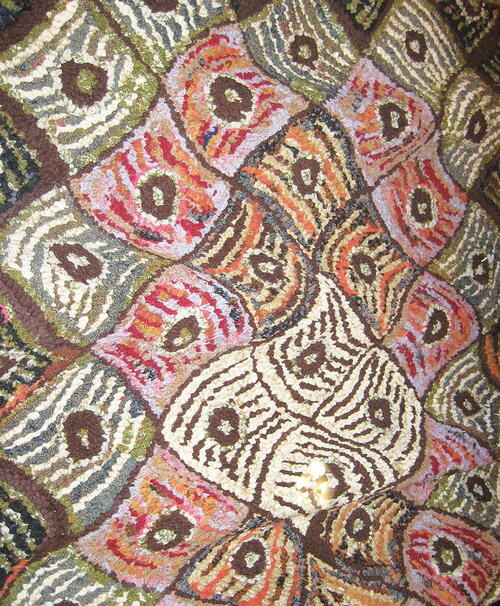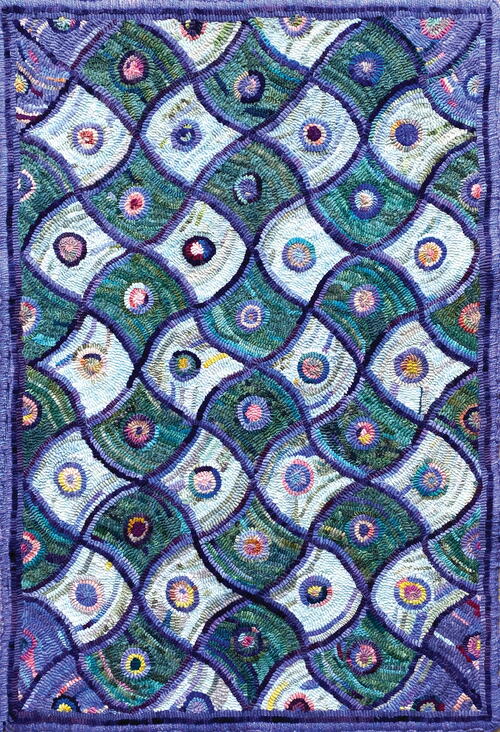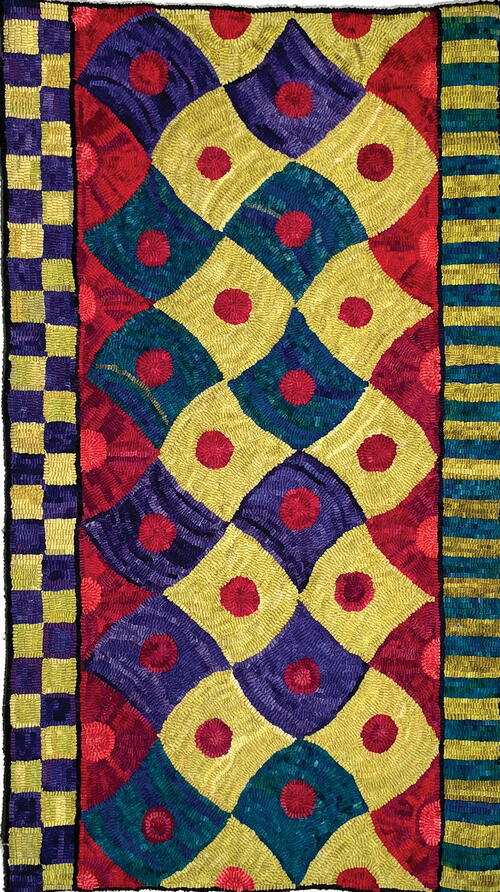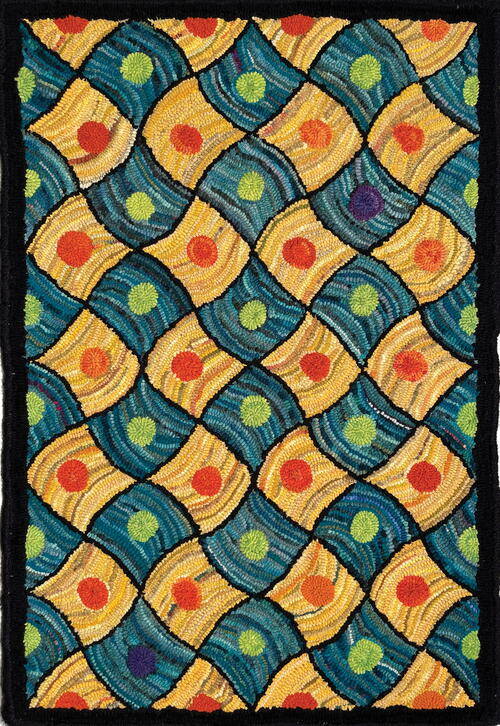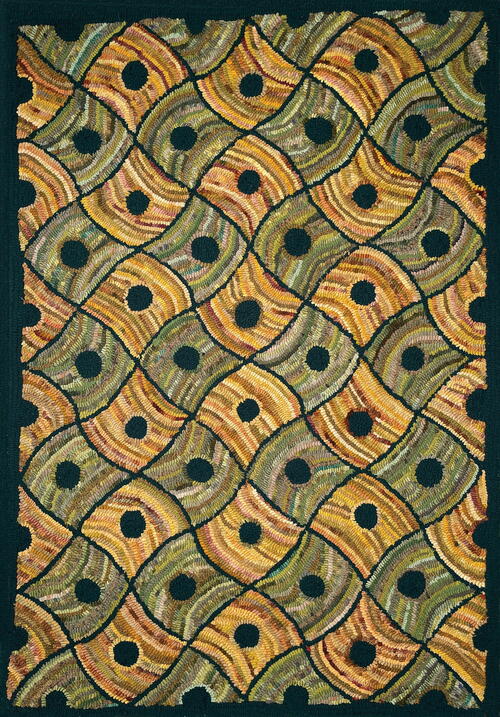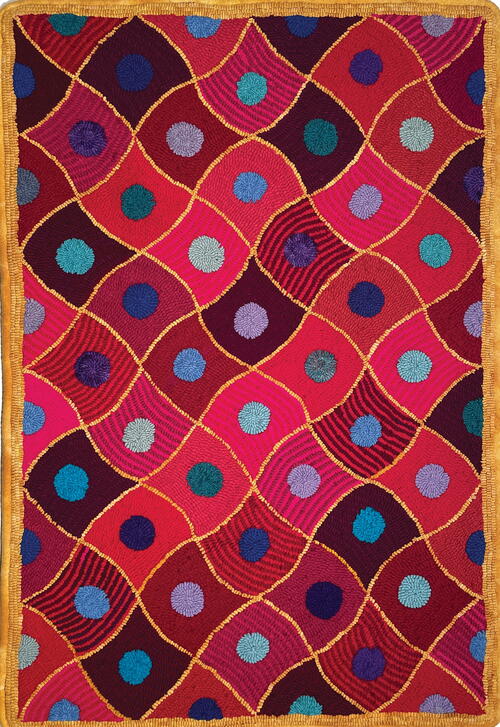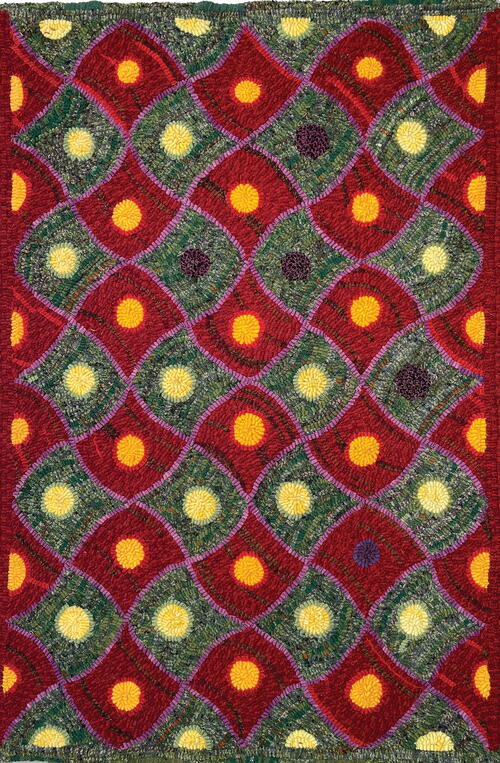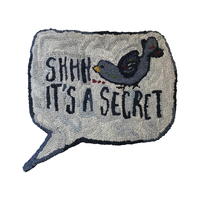Two Hookers and a Guy Named Duncan
Fascinating Rhythm and Geometric Design

Once upon a time a naive young hooker took a trip from Pennsylvania to Virginia and met a guy named Duncan. Fifteen years later, a friend of hers became infatuated with Duncan too. This is their story.
ERIC SANDBERG, (image on the right) Onancock, Virginia. #6- and 8-cut wool on linen, 2003. The rug that began our affair with Duncan. Eric’s rug is joyful and dynamic. His masterful alternating of the patchwork of colors and stripes makes Duncan dance before our eyes, and the effect is enhanced by the vibrant scarlet circles. -ERIC SANDBERG
At a workshop in Virginia very early in my hooking career I met Eric Sandberg and fell in love with his rug, Duncan. Always a sucker for geometrics and a lover of antique quilts, I knew immediately that I had to hook this rug. Eric was charming and generous, and his rug, with its rhythmic movement and scarlet circles, was irresistible. I don’t remember how I learned that this was a Pearl McGown pattern, but before too much time had elapsed, I was hooking it in a workshop with Gail Dufresne. Initially I found it challenging, my inexperience causing some frustration. Then I got the hang of hooking the curving outlines, creating the checkerboard pattern, and reinforcing the rhythm of the design with directional hooking. Gail was patient, it got easier, and I enjoyed watching the pattern come to life with alternating orange dots against a hit-or-miss palette. It was a great learning rug and, although the execution is simplistic compared to what I might choose today, I still enjoy it.
-
KATHLEEN HARWOOD, South Hadley, Massachusetts. #5- to 9-cut wool on linen. Duncan One was inspired by Eric Sandberg’s beautiful rug. It was a learning rug for me—I was a relatively new hooker at the time, which shows (I think) in the somewhat rigid checkerboard arrangements. But I was learning about contrast, gaining confidence, and I indulged my passion for orange. I love my first Duncan. One must ask: as a novice hooker, how in the world did I already have so many worms? -KRIS MCDERMET
I ran into Duncan in the exhibit in Connecticut in 2009, but never learned his name (or how to get in touch with him) since he didn’t have a label. Ten years later I still wanted him in my house, and finally drew a bad version of the pattern in early 2020 from the old photo I had taken at the exhibit. When I showed my idea to Kathleen, I was shocked to hear this was a McGown pattern; I immediately called W. Cushing & Co to get a legitimate version on linen (theirs was so much better drawn). Duncan is deceptively simple looking, but it’s quite a challenge. I had more than three-quarters of the rug hooked when I realized I wasn’t happy with my original color plan and pulled out half of my work to change colors. I like my result and I’m still in love with Duncan. There may even be a second Duncan in my future. The possibilities are endless.
Many years and many rugs later my friend and fellow hooker Devin Ryder was telling our Rug Social group in Brattleboro, Vermont, about an unlabeled rug by Lida Skelton Ives (1902-1988), seen in an exhibition at the University of Connecticut. She could not get this rug out of her mind. Logically assuming it to be an original Ives design, she had drawn a copy on linen with plans to hook it. But when she showed us her photograph, it was Duncan! Little wonder it did not occur to her that it was a McGown pattern; it’s atypical of what we associate with Pearl.
Unfortunately, the history of the Duncan design, and even the name, is murky. Its number in the McGown system is 809, telling us that it is from the 1970s and not earlier, as it might appear to be, but no more information is available. Eric Sandberg told us he felt it was Pearl’s interpretation of a log cabin quilt design, leading him to his choice of a hit-or-miss palette and traditional red for the circles. I have always believed it was based upon a quilt, although I’ve never seen a quilt just like it. In any case, it’s a dynamic, rhythmic, and playful design which lends itself to endless interpretations. Most often, and logically, hooked as a checkerboard, it can also be more graphically complex or wonderfully random; carefully planned or seemingly spontaneous. Its suitability for using leftover wool makes it an appealing choice of pattern. Duncan’s charisma continues. He seduced several of our fellow hookers: members of Rug Social (Brattleboro Vermont) and/or the Quabbin Chapter of ATHA (Amherst, Massachusetts), who decided to hook the pattern along with Devin and me. These are the results. We hope to organize an exhibition of them at Sauder Village in 2023. And should you be inspired to hook your own Duncan, the pattern is available from W. Cushing & Co. in the standard 25" x 37" size and in custom sizes.
-
LIDA SKILTON IVES (1902-1988, Western Connecticut)
Lida’s Duncan is different from all the rest and is challenging to characterize. It appears to be random yet suggests an organization of the squares. The palette is unified by the olivey-gray-green-brown that both outlines the blocks and figures in many of them. There is an energy, fueled by the lavenders, magentas, and orange tones in some blocks. Altogether a unique and impressively dynamic execution, and more “primitive” in tone than the more recent examples. -DEVIN RYDER -
DEVIN RYDER, Greenfield, Massachusetts, #8-cut wool on linen
Devin’s love affair with Duncan started this whole project. She says her rug is all about the colors, but it’s also about the prominent double borders that accentuate the rhythm of the design and the impact of the irregular center rounds. Using the checkerboard approach, she discarded an early green and peach color plan in favor of this very original opal-y, purple violet, and green rug. All the wool came from her stash. -DEVIN RYDER -
PAT DODGE, Putney, Vermont. #6-cut wool on linen
Pat altered Duncan to fit the spot where she wanted to place it. Her lively adaptation, with its brilliant choice of geometric borders and vibrant colors, takes this pattern to a new level, and demonstrates just how uniquely individual and joyful it can be. -KRIS MCDERMET -
LYNDA FAYE, Amherst, Massachusetts. #4- and 6-cut wool on linen
Lynda had never hooked a geometric rug and, in fact, had a serious aversion to the idea. She hooks her own very creative designs but was intrigued by the challenge Duncan presented. Deciding on a yellow and turquoise palette because she “had a lot,” she began hooking and was dissatisfied with the results. Cooking the yellows and blues (separately) to blend made things much more harmonious, and she persevered; adding the purple circles made her like it better. She has a rug that her daughter loves and now she has “ticked off the geometric box.” -KRIS MCDERMET -
TRICIA TAGUE MILLER, Alstead, New Hampshire. #7-cut wool on monk’s cloth
Tricia is an accomplished hooker, most accustomed to ambitious complex designs hooked in a #3-cut. Rugs that do not go on the floor. Analyzing her stash, she decided to concentrate on greens and golds, cooking lots of disparate bits and pieces together with Synthropol to blend the colors. She says it’s a great project for using up little pieces, which helped to create the stripe-y look that highlights the geometry of her rug. She “embraced the wonkiness of the circles” and likes that it’s a playful rug that can be put on the floor and can go anywhere. -KRIS MCDERMET -
SUZANNE FLYNT, Dummerston, Vermont. #7-cut wool on linen
Suzanne’s modern Duncan was carefully thought out. Often hooked as a hit-or-miss checkerboard, the pattern is also striking when structured with care and three or more colors to maximize its graphic impact. Suzanne’s rug was made as a wedding gift for her daughter and soon-to-be son-in-law, who have distinctly contemporary taste and a love of orange. She plotted a graph, worked with colored pencils, carefully annotated her linen, and hooked a meticulous Duncan in multiple shades of oranges, blues, and greens with wool from Fluff and Peachy Bean, which she admits are “totally not on her radar.” Her favorite part of Duncan? Its dynamic movement. -SUZANNE FLYNT -
ANN CAIRNS, Shrewsbury, Massachusetts. #6-cut wool on linen
Ann’s rug is another different, “not a checkerboard” Duncan. She used her collection of reds and pinks as a springboard and then went with “a kind of triadic color plan” in a hit-or-miss rug. She remained conscious of the effect of warm tones for the squares and cooler colors for the circles and is happy with her choice of golden mustard for outlining which, with the squares with stripes, emphasizes the curves in the rug. She also scattered the colors of the circles so they would be random and not predictable. -KRIS MCDERMET -
BARB ACKEMANN, Brattleboro, Vermont. #7-cut wool on monk’s cloth
Barb’s favorite thing about her rug is the colors, red and purple, which make her think of the poem “When I Am an Old Woman I Shall Wear Purple.” And it reminds her of a rug her grandmother hooked. She neither dyed nor purchased wool, but gathered reds and purples from her stash, worms, and pieces. Partway through hooking she realized she could run out of some scraps and had the very sensible idea to “deal out her worms and scraps into the same number of piles as remaining squares” to distribute her leftovers throughout the rug and maintain the continuity of variety she had already established (great tip, Barb!). -KRIS MCDERMET -
KATHLEEN HARWOOD, South Hadley, Massachusetts. #8-cut wool on linen
I began Duncan Two in March 2020 and knew it would be a COVID memorial rug. My challenge was to make it somber but not sad; I often cried during those months, but hooking, as always, was wonderful therapy. I had lots of green and red wools (the classic great combination) and threw in the bright purple outlines at the last minute—just because. The dark circles honor deaths of the 100,000 (500,000 when I finished the rug. One million when this article appears in RHM.). The gold and pale-yellow suns and moons represent hope for the future. My favorite part: what I love about every Duncan, the wonderful movement in the dynamic composition. -KRIS MCDERMET
Kathleen Harwood has enjoyed a long and rewarding career in the arts. A member of the Celebration Hall of Fame, she began hooking in 2002. She hooks original designs, primarily geometric studies, animals, and message rugs, and is increasingly drawn to abstraction in the textile arts.
Devin Ryder started hooking in 1970, paused for 15 years, restarted, and has never looked back. She writes about her passions for textile art, drawing, and meditation at www.drawingfromtheday.com.


